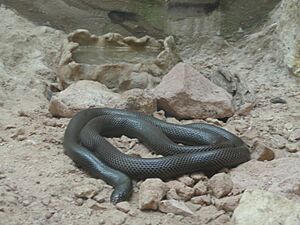Israeli Mole Viper facts for kids
Quick facts for kids Atractaspis engaddensis |
|
|---|---|
 |
|
| Atractaspis engaddensis | |
| Conservation status | |
| Scientific classification | |
| Genus: |
Atractaspis
|
| Species: |
engaddensis
|
The Atractaspis engaddensis, also known as the Israeli Mole Viper, is a venomous snake. You can find it in countries like Egypt (specifically the Sinai Peninsula), Palestine, Israel, Jordan, and Saudi Arabia. Its name comes from Ein Gedi, a place near the Dead Sea where it was first discovered. In Arabic, it's called "الأسود الخبيث" (al'aswad alkhabith), and in Hebrew, it's known as "שרף עין גדי" (Saraf Ein Gedi) or "צפעון שחור" (Tzifon Shachor).
Contents
About the Israeli Mole Viper
This snake is quite venomous and lives in the Middle East. Its body is usually dark black. It has small eyes with round pupils. Both its head and tail are short and pointy. This makes it hard to tell which end is which, even for experienced people! This snake usually grows to be about 60 to 80 centimeters long. When it feels threatened, it rolls up with its tail in the air and hides its head under its body.
The Israeli Mole Viper is mostly active at night. It lives in dry or partly dry desert areas. It likes to stay in burrows underground, which is why it's called a "mole viper." You might also find it under rocks. On warm nights, it sometimes comes out to warm itself on roads. Even though it mostly lives in the desert, it can also be found near desert oases, streams, and springs where there's more moisture. Sometimes, it even goes into places where people live.
Life Cycle and Reproduction
These snakes usually mate in July or August. This is a bit later than many other snakes. It might mean they originally came from warmer, tropical places.
From late September to November, the female snake lays 2 to 3 eggs. These eggs are about 75 millimeters long. They need a humid, or moist, place to develop properly. The eggs are quite large compared to the size of the snake itself. After about 3 months, the baby snakes hatch. They are born with their venom system already working, just like their parents.
What They Eat
The Israeli Mole Viper mainly likes to eat baby snakes that have just hatched. But they also eat lizards and small mammals, like young rodents.
Venom and How They Bite
The venom of the Israeli Mole Viper is very strong. It contains special substances called sarafotoxins. These substances mostly affect the heart. They can cause problems with how the heart beats.
Currently, there is no specific medicine, called an antivenom, for the bite of the Israeli Mole Viper.
This snake has a very special way of biting. Its fangs can move outside its mouth. This means it can stab sideways even when its mouth is closed! This makes it very tricky and dangerous to catch. It can bite unexpectedly. For example, a zoologist named Heinrich Mendelssohn was bitten this way in 1944 when he first found this snake.
Luckily, this snake doesn't interact much with humans. It mostly lives in deserts and underground. It's also not very aggressive and reacts slowly when bothered. Because of this, bites on humans are quite rare. Even though its venom is strong and there's no antivenom, most people who are bitten survive with little or no lasting harm. Even small children can recover with the right medical care. This is because its fangs can't go very deep into the skin.
Because of all these reasons, very few people have died from this snake's bite. Since it was discovered in 1950, only 2 or 3 fatal cases have been recorded. The most recent death happened in 2002. A man was trying to catch a snake near his home close to the Judean Desert.


